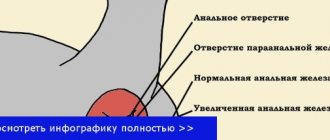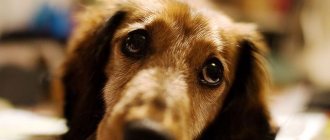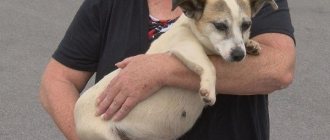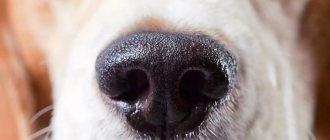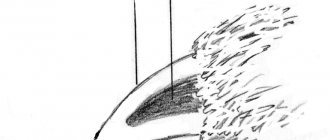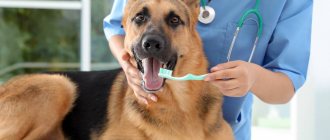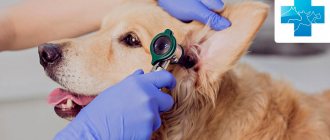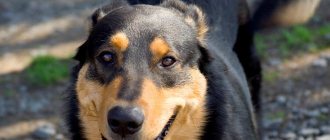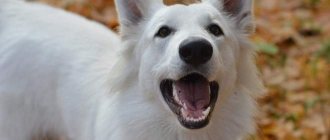Paraproctitis in dogs is one of the most common diseases of the excretory system. The disease affects the lower rectum, anus, anal glands and surrounding tissues. These organs are in direct contact with feces, which means they have an increased risk of infection or helminth damage. The slightest injury to them under conditions of low immunity can lead to illness. From this article you will learn what paraproctitis is, its causes and characteristic symptoms, what its main danger is for a dog, as well as methods of treatment and prevention.
Mechanism of disease
Paraproctitis is an inflammation of the tissues surrounding the anus and rectum as a result of the penetration of a bacterial infection from its lumen. The cause of infection is microtraumas resulting from exposure to dense feces and solid inclusions.
If, against the background of high temperature and intoxication, the dog experiences inflammation and redness of the anal area, the formation of an abscess, and the discharge of purulent infiltrate from the anus, then it must be shown to a veterinarian to confirm or exclude the diagnosis of paraproctitis.
Paraproctitis can also be a consequence of inflammation of the paraanal glands in a dog. These are special organs of external secretion. They vary in size and can be the size of a bean or a walnut (depending on the size of the dog). The glands are located just under the skin, on the sides of the anus. They produce a special odorous dark gray secretion, the functions of which are varied. The pungent odor has the following purpose:
- determining a dog’s individuality in a society of its own kind (this is its kind of “calling card”);
- marking one's own territory;
- attracting individuals of the opposite sex;
- scaring away enemies;
- help with bowel movements during bowel movements.
Emptying of the anal glands occurs during defecation when the dog tenses the perianal muscles, thereby squeezing the glands. If there is no stool for a long time or it is liquid, the para-anal secretion stagnates, thickens and clogs the glands. As a result, they can swell and become inflamed, which will also lead to the development of paraproctitis.
According to some veterinarians, the anal organs in dogs are in some sense rudimentary, since there is no longer a need for their active functioning. This fact is the main reason for their frequent blockage.
Photo gallery
Cleaning the anal glands in a veterinary clinic
Dog's anal sacs
A dog chews its tail due to inflammation of the anal glands
Possible complications
Paraproctitis in dogs is difficult to cure, because due to constant irritation and infection of the affected area with feces, healing is very slow. Sometimes the disease progresses so actively that complications develop:
- paraanal fistulas occur near the anus and can open outward or into the rectum;
- if treatment is delayed, then prolonged inflammation may be complicated by sepsis;
- advanced paraproctitis contributes to the formation of scars in the walls of the anal canal, which subsequently complicates the process of defecation for the dog;
- with frequent recurrence of chronic paraproctitis, there is a possibility of developing cancer in the affected area.
How is the diagnosis carried out?
In the vast majority of cases, to determine the cause of the formation of a lump under the dog’s tail, a simple examination and palpation of the area around the anus is sufficient. True, it is advisable that this be done by a veterinary surgeon, and not by an ordinary specialist conducting an appointment at the clinic.
To determine the stage of the inflammatory process (if we are talking about paraanal sinusitis), clarifying procedures may be required, in particular:
- rectal examination of the paraanal sinuses;
- collection and examination of anal gland secretions (performed using a syringe);
- clinical, biochemical and chromatographic blood analysis;
- microscopic analysis of skin scrapings.
Oncological diagnostics are prescribed in cases where paraanalysis is not confirmed or the results of tests give reason to suspect cancer (for example, an increased content of parathyroid protein and a high level of calcium are found in the blood).
The following diagnostic measures allow cancer to be identified:
- X-ray of the chest and pelvis;
- ultrasound examination of the abdominal cavity;
- biopsy of the paraanal glands followed by examination of the microflora, cytology and dermatohistopathology of their contents.
If the compaction on the x-ray is a thickened secretion, then the contents of the glands are taken to evaluate the microflora. This analysis subsequently allows you to prescribe antibacterial therapy.
Did you know? In 1925, an event took place in Alaska that went down in history as the “Great Race of Mercy.” A relay race of 20 dog sleds, covering a distance of 1085 km in 5 days, delivered the life-saving serum to a small town affected by a diphtheria outbreak.
Causes of the disease
Practice shows that active dogs that do not have digestive problems suffer from paraproctitis much less often. From this we can conclude that the main causes of the disease are low physical activity, pathologies of the gastrointestinal tract and various errors in diet and nutrition.
In addition, there are many other provoking factors:
- breed and hereditary predisposition (German shepherds are most susceptible to the disease, as well as Labradors, Irish setters, collies and spaniels);
- overweight and obesity;
- diseases of the immune system, low body resistance to infections;
- constant violations of hygiene of the anal area;
- eating bones (especially tubular ones);
- diseases of the lower rectum (hemorrhoids), frequent constipation and diarrhea;
- the presence of a large amount of protein foods in the diet;
- active matings.
Dog diet and feeding
When delving into the problem, the owner should understand that the main thing is feeding. Formed feces, dense, hard, are capable of independently carrying out “sanitation”. The owner must monitor the formation of fecal matter. This is especially true during the period when food is changed or new food is introduced into the diet.
The dog's diet should include:
- proteins;
- fats;
- carbohydrates.
However, carbohydrates come last. The dog is a carnivore. The basis of the diet should be:
- meat and offal;
- bones (pork, beef, poultry);
- dairy products;
- eggs.
It is not correct to think that the listed products are a diet - this is the basis. Take a closer look at the diet; if feces are often not formed, then feeding is not physiological. The food should be reconsidered.
Symptoms of the disease
Acute paraproctitis in dogs has symptoms of purulent tissue inflammation:
- itching and severe pain, as a result of which the dog constantly pays attention to the anus area, licking and biting it;
- an unpleasant pressing sensation due to blockage of the anal glands forces the animal to ride on the floor on its fifth point, in the hope of relieving its condition;
- an unpleasant odor emanating from a dog is a characteristic symptom that indicates stagnation of the secretion;
- painful sensations lead to the fact that the dog can no longer express his emotions by wagging his tail, since this is quite painful for him;
- general intoxication, high temperature and pain are reflected in the appearance and behavior of the dog. She eats nothing, loses weight, becomes lethargic and moves little;
- inflamed and enlarged paraanal glands can be seen with the naked eye. They can reach the size of a large tangerine;
- due to constant irritation of the nerve endings, the dog loses control over the act of defecation, defecating at any time and in any place.
Chronic paraproctitis develops if the acute form of the disease is untreated. Its symptoms and treatment are similar, but longer, since at this stage a perirectal fistula often develops with periodic formation and opening of a purulent abscess.
Carrying out cleaning yourself
You can clean the anal glands at home for therapeutic or preventive purposes. This requires the use of Vaseline oil and durable medical gloves.
In small breed dogs, cleaning is carried out externally. Using a sterile napkin, the anal area is gently squeezed, and the contents will be released from the glands. Since it has a strong unpleasant odor and can permanently ruin a valuable item, it is best to carry out the procedure in the bathroom.
For larger dogs, cleaning is done differently. A gloved finger is inserted into the dog's anus, generously lubricated with Vaseline oil. Having felt the gland, you need to massage it very carefully and carefully, forcing the contents to come out. The same is done with the second gland.
When they are both empty, you need to very carefully toilet the animal, washing the area with warm water and soap or another mild detergent. This must be done, as the remaining secretion will cause severe irritation. Plus, they smell bad, to put it mildly.
To avoid possible inflammation or the spread of infection, immediately after the procedure the dog needs to be given an anti-inflammatory suppository - a special suppository for dogs.
Treatment of the disease
Even before visiting a veterinary clinic, the owner can provide a sick dog with pre-medical care, which will somewhat alleviate its condition. It is as follows:
- relieve severe pain with painkillers;
- change the diet by eliminating bones, roughage and including easily digestible food.
It is unacceptable to try to treat a dog yourself. Treatment tactics are selected by a veterinarian after diagnostic procedures:
- examining the animal and palpating the affected area;
- asking the owner about the nature of the disease;
- conducting a biopsy to determine the nature of inflammation of the paraanal glands and exclude malignant neoplasms.
Then therapy is prescribed aimed at eliminating the underlying cause of the disease. At the initial stage, conservative treatment is undertaken. In case of insufficient effectiveness, surgical methods are turned to.
Conservative treatment
Conservative treatment is as follows: the affected areas are disinfected, after which the paraanal glands are cleaned. The resulting cavities are disinfected, then antimicrobial drugs are injected into them. Anti-inflammatory rectal suppositories with ichthyol are also used. If local treatment is not enough, the dog is prescribed a course of antibiotics.
Surgery
In case of complications in the form of fistulas and purulent abscesses, after complete anesthesia, the purulent focus is opened and the pus is pumped out, after which the source of infection is completely eliminated. After a course of antibacterial therapy, the walls of the fistula are excised. If blockage of the paraanal glands becomes a constantly recurring symptom, surgery to remove them (saculectomy) is prescribed.
Cleaning your dog's anal glands
An attentive owner will quickly determine how often gland blockage occurs. If this phenomenon is frequent, then cleaning is carried out once every 7-10 days.
The procedure is carried out using a damp cloth after bowel movement. Place a damp cloth on your hand and apply it to the sub-caudal area in the anus area. Pressing lightly, the fingers seem to slide from the sides to the center of the sphincter. The procedure is carried out with the tail raised as high as possible, not pulled to the side, but upward. This is how reflexive relaxation of the muscles occurs and manipulation is easy to carry out.
Genetic predisposition imposes a number of responsibilities. Cleaning the glands, as well as the ears, is a normal, regular event. There is no point in doing this in the bathroom using asepsis (gloves, shoe covers, etc.) this is a hygienic procedure. Even simply wiping the anal area with a napkin will be sufficient to prevent blockage of the excretory ducts.
If examination and sanitation is problematic for the animal owner, then you should visit the clinic. This should be done once every 2-3 months and immediately when any signs are detected. Perhaps the doctor conducting the examination and procedure will change the frequency and give his recommendations.
Prevention of the disease
Prevention of paraproctitis involves periodically cleaning the dog’s paraanal glands. This is the most effective method to help avoid disease. In addition, there is a list of additional preventive measures:
- Active pet walking. It is necessary to physically load him, take long and long walks more often.
- Drawing up a proper diet, which should contain no bones and very rough food.
- Timely immunoprophylaxis. It is necessary to ensure that the amount of vitamins and microelements in the diet corresponds to the norm.
- Monitoring the condition of the gastrointestinal tract. It is important to carry out prevention and timely treatment of constipation and diarrhea.
Paraproctitis must be treated promptly, as the disease causes severe suffering to the pet. And if complications arise, there is also a threat to life. The earlier it is detected and treated, the more likely it is that there will be no relapse. If the infection is started, the unpleasant consequences can last a lifetime.
At-risk groups
The risk group includes pregnant and lactating females, as well as some representatives of small breeds: dachshunds, pugs, Pekingese, Spitz, Shih Tzu. If you follow the recommended caloric intake of food and regularly walk your pet, not forgetting about outdoor games, make sure that he is not naturally prone to excess weight. In this case, any deviation from the listed actions is fraught with the sudden development of pathology.
